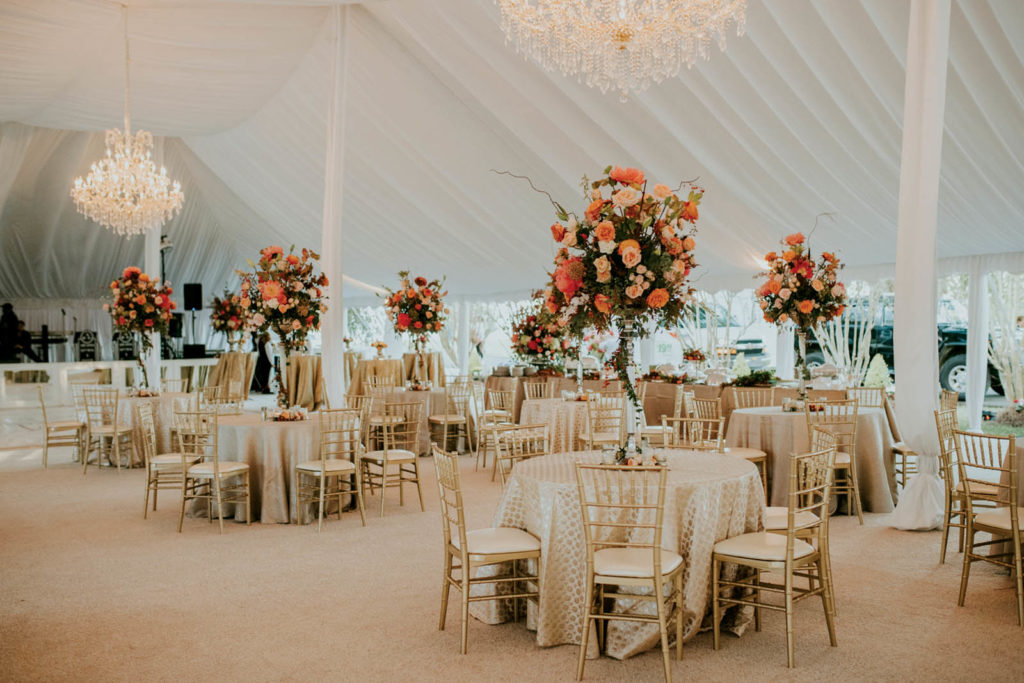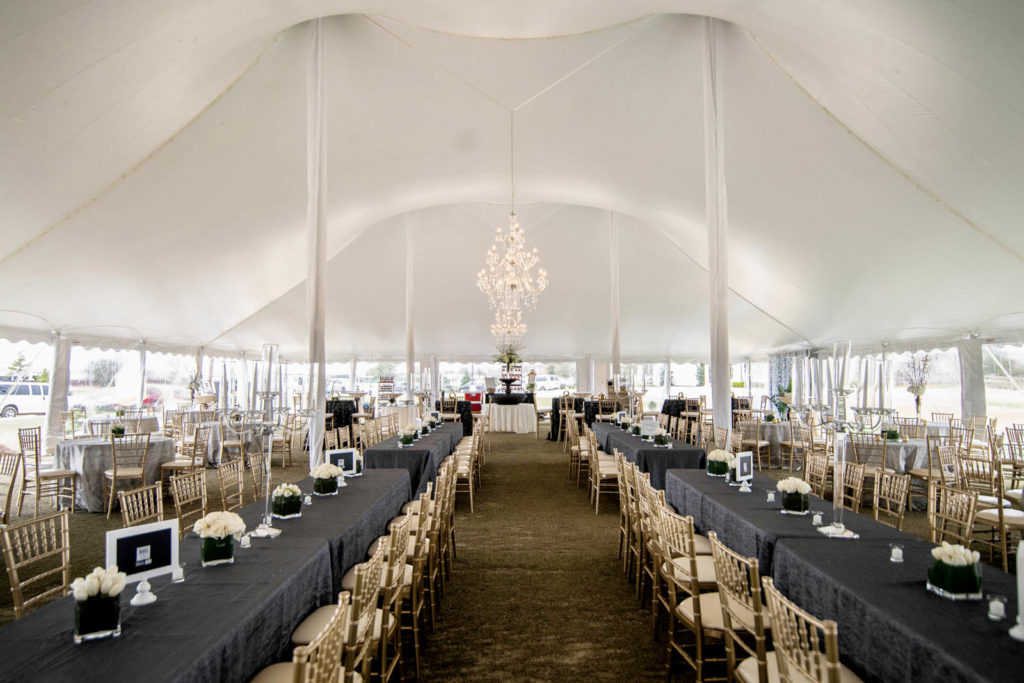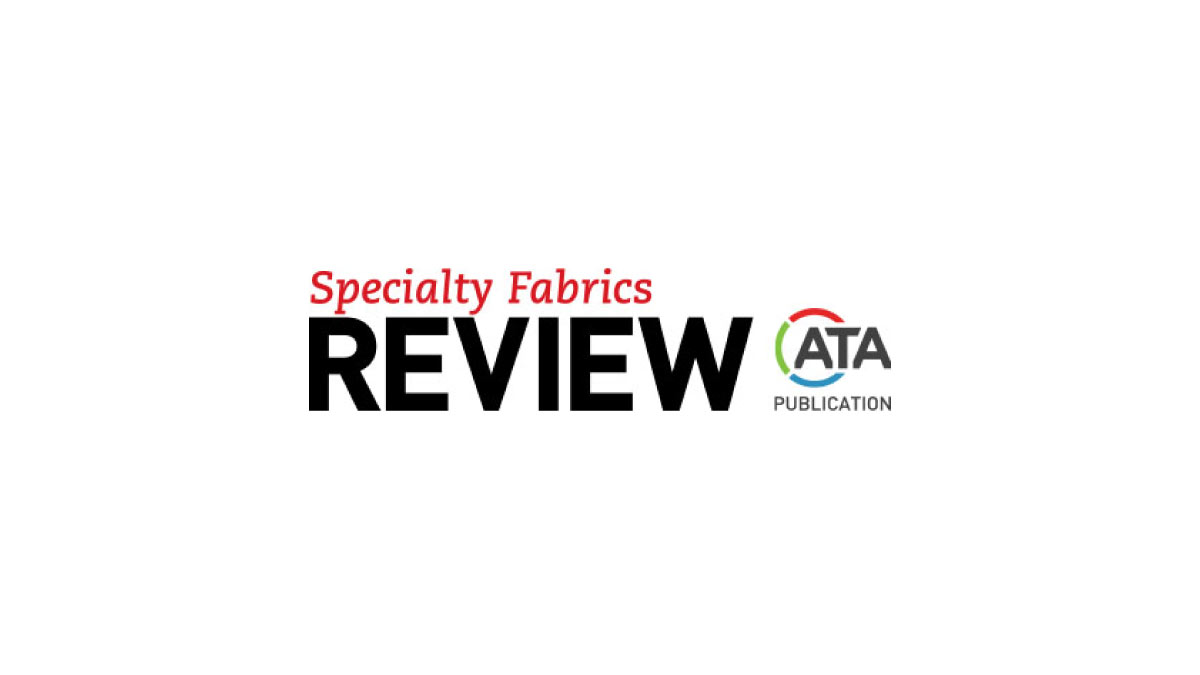Although not typically the star player when it comes to tented events, lighting nevertheless plays a strong supporting role, capable of adding to, or detracting from, the overall ambience of an event. Make the wrong lighting choice and the result can be an event that is somehow off, where the decor’s impact is lessened, the desired mood or feeling isn’t achieved and even the beautiful elements—such as a lovely clear-top tent providing a view of the starry night sky—are obscured and compromised.
Fortunately, there are many options for lighting a tent, with applications ranging from decorative to functional, says Chris Mertens, national sales manager for Tentwares Accessory Catalog. Headquartered in Manchester, N.H., Tentwares provides a wide variety of products to the rental and party industries, serving as a one-stop shop for rental companies, says Mertens.
“Decorative lighting solutions have different lengths of white or black cords and can utilize either incandescent glass lightbulbs or shatter-resistant LED lightbulb options,” he explains. “These different styles and sizes of decorative lighting allow the tent to be draped or washed with light.
“For more functional lighting there are LED high bay, LED PAR cans or standard PAR cans light options,” Mertens continues. “Dimmers can also be utilized via dimmable bulbs and correct dimming technologies, allowing for different styles of lighting to help soften or change the look of the space.”
It’s not just weddings and parties that utilize tents and therefore lighting. As the industry knows, the pandemic saw tents being deployed in all manner of outdoor spaces, such as parking lots, sidewalks, deck areas and streets, all of which required some form of lighting, says Kevin Cody, founder of FLI Products. Headquartered in West Chicago, Ill., the company manufactures and distributes LED lighting, portable fans and other products for the events and exhibits industries, as well as for hardware/home centers and others.
Tents serving a medical purpose have relied on functional lighting, while those installed at restaurant or hospitality venues have opted for decorative, sparking a “significant increase in patio string lights,” says Cody, explaining that their ease of install and the effect they impart have made these very popular lighting choices. Another consideration when it comes to tents installed outdoors for long-term use is the need for security lighting to protect the assets, says Cody, creating a demand for battery-operated LED motion security lights.
Hot and not
First a word about solar lights—these are definitely not trending for tented events, says Eric Todd, president and CEO of BML-Blackbird. Located in Fair Lawn, N.J., the company is a provider of lighting, audio, staging, LED screens, rigging and more to thousands of venues, including major concert tours, TV and award shows, the Olympics, presidential events, Super Bowl events and others. BML does the installs and also provides the designs, although in some cases, depending on the client, the company works with designers or recommends an outside designer.
“These fixtures aren’t very popular,” he says of solar lights. “They can’t be used inside and their quality, as of now, is not something one would use inside, unless for a one-time use. Events can’t be left to chance. At some point these may become more popular but someone would be better off coming up with solar charging stations for the batteries.”
Moss Duvall, owner of Pelican Tents & Events LLC, a full-service party and event company in Shreveport, La., agrees solar lights aren’t practical. In fact, among his expansive lighting inventory he doesn’t have any solar. String lights and chandeliers (utilizing conventional bulbs) are his most popular.
“We do a lot of both,” he says. “We also do a lot of battery-powered lighting, such as 1-by-1-foot box lights for both interior and exterior. These can be set to any color and can flash—like for a disco theme—and they also have dimmers, for example if doing a black-light, glow-in-the-dark party. They can be hung or placed on the floor, but they’re most commonly used on the floor for up lighting.”
Duvall, whose company handles the lighting installs, says he also gets a lot of requests for wireless LED pinspot lights. These are magnetic and can be hung up high and controlled by a remote. Used for down lighting, they’re good for highlighting particular features, such as a flower arrangement, or illuminating a wedding cake.
A new product for him is the LED lighted wall. Incorporating smaller LED lights, the wall comes in 10-foot widths, with lights strung vertically and placed about an inch apart. The wall, which provides a backdrop of lights, is available in heights of 10 or 15 feet but can be daisy-chained together for added length. Purchased right before COVID, it’s proven very popular, says Duvall, adding that Pelican Tents often places a sheer drape in front of the lights, creating a nice illusion.
Duvall is adding to his lighting inventory all the time. But he’s not bringing in conventional fixtures. Instead he anticipates going all LED, even with chandeliers (which now offer LED options). However, as long as his current chandeliers are in good shape, his inventory won’t be entirely free of conventional fixtures.
Although conventional fixtures still have their place, mainly because of customers’ budget considerations, Todd says BML is also in the process of whittling down its stock of these.
“We used to have almost 10 million watts of dimming for conventional lighting but we sold over 90 percent of this off,” he says. “I believe in another two years or so we won’t see any conventional fixtures.”

The LED advantage
LED fixtures are popular for many reasons, such as reduced power consumption and output, says Todd, mentioning their output is anywhere from 1/8 to 1/10 that of conventional lights/fixtures. This takes away the heat element that can damage tent fabric and be dangerous to the touch. Unlike some conventional (dimmable tungsten) lighting fixtures that utilize much heavier cable, LED fixtures require less and smaller cabling, making concealment under carpeting or matting easier. Also desirable is their ability to change color.
“Conventional lighting fixtures do not change color without adding an expensive color changing accessory that is completely out of fashion,” Todd explains. “For this reason, conventional lighting fixtures have a gel filter added in a single color. The majority of LEDs have vast color-changing capabilities.”
There are several types of LED fixtures, explains Todd. The broad-beamed washes provide a light that is more diffused and are commonly used for tented events. The profile/framing projector-type LEDs allow users to put in gobos, very useful for logos and branding or to frame light very specifically, such as on a podium, dance floor, stage, wedding cake and so on. There are also the aforementioned wireless, magnetic pin spots (“extremely popular”) and LED retro/vintage lighting. This latter is a “trend to watch,” says Todd, especially the oversized lamps with large filaments.
The battery-operated LED fixtures—of which there are a goodly amount that are very high quality, says Todd—are also often deployed to light up pathways or for up-lighting trees, tent exteriors and so on. Among their advantages is that they don’t present a trip-and-fall hazard, you can drop them anywhere and they’re ready to go, with most operable by a wireless control. They can also be programmed to change color.
Mertens says he’s seen customers trending to shatter-resistant, acrylic LED bulbs or lights.
“The LED bulbs allow the customers to plug in more lighting together, use less electricity, and because they are shatter-resistant, they don’t need to be replaced or even taken out of the sockets when moving the lights,” he says. “Although these currently have a higher upfront cost to the customer, they’re proving to be worth the investment in labor hours saved and not having to constantly buy and replace traditional glass bulb options.”
“For these lighting solutions, we see LED bulbs dropping in costs over time, making them a more affordable option,” Mertens says.
Pamela Mills-Senn is a writer based in Seal Beach, Calif.
SIDEBAR: Artful illumination

Ready to pack in even more wattage to your lighting installs? For greater impact, consider these tips:
- Don’t obstruct. When lighting clear-tops, avoid up lighting, says Eric Todd, president/CEO of BML-Blackbird, Fair Lawn, N.J., since this washes out the clear-top and could interfere with the view—the whole point of this tent style. Instead, Todd suggests mounting down lights as high as possible, saying this often provides a much better result.
- Take it outside. If there are trees around the tent, Moss Duvall, owner of Pelican Tents & Events LLC, Shreveport, La., likes to up light them since, inside the tent, you can see their shadows shining through. Also, for a nice illusion, use string lights inside a sailcloth tent, he advises.
- Show restraint. “White tents are a lighting designer’s dream, [providing] a perfectly clean white canvas that can be painted in any number of ways,” Todd says. “[But] more does not mean better; more means more. Creativity counts.”




Leave A Comment